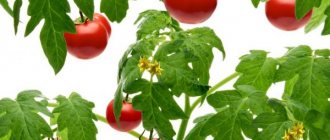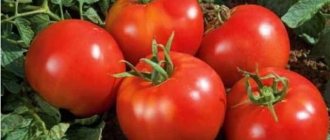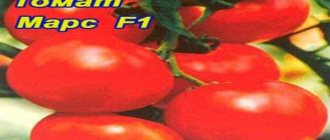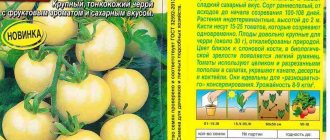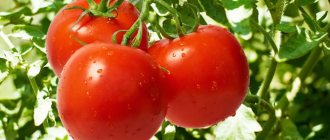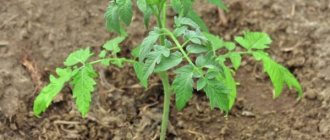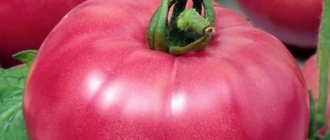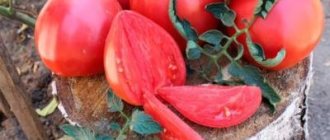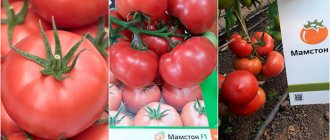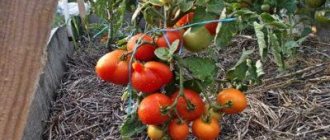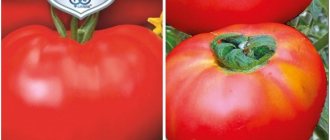Tomato variety “Kish mish red F1”: photos, videos, reviews, description, characteristics, yield
The tomato hybrid "Kish Mish Red" is a variety of cherry tomatoes. It got its name because of its resemblance to grapes. Small tomato fruits abundantly cover the bushes, resembling bunches of grapes. Tomato bushes not only decorate your garden plot, but also delight you with their taste. Small, sweet tomatoes with a rich red color are good as a snack and dessert.
Origin of the tomato hybrid “Kish mish red F1”
The hybrid tomato “Kish Mish Red” was bred by Russian breeders on the basis of agro.
Description of the variety
Fruit:
- Shape - oval, plum-shaped or spherical;
- Color: deep red;
- The skin is thin, resistant to cracking;
- The pulp is juicy, fleshy;
- The taste is pronounced, delicate, sweetish;
- Weight - from 12 to 23 grams.
Bushes:
- Indeterminate type;
- Tall. Height varies from 160 to 200 cm.
Tomatoes: advantages and disadvantages
The tomato hybrid “Kish Mish Red” has the following positive qualities:
- Same fruit size;
- Universal purpose of the harvested crop;
- Excellent taste characteristics;
- Ability for long-term storage;
- Possibility of transportation over long distances;
- Resistant to cracking;
- Good heat tolerance;
- Unpretentiousness in care;
- Immunity to tobacco mosaic, fusarium, verticillium, nematode.
The disadvantages of the hybrid include:
- The indispensable presence of a greenhouse structure for cultivation in regions with a cool climate;
- Moderate resistance to viral mosaic damage, as well as late blight.
Application of fruits
The hybrid “Kish Mish Red” is a universal tomato. The fruits are good for fresh consumption, and are also used for preparing salads, first and second courses. Due to their small size, they are suitable for canning whole fruits. After heat treatment, they completely retain their shape, which makes the fruits suitable for pickling and pickling.
Growing tomatoes
To cultivate a hybrid, it is advisable to give preference to the seedling method.
How to prepare seeds?
Seed material of hybrid tomatoes does not require additional processing, since all necessary procedures are carried out immediately before sale by the manufacturer.
Sowing seed material
Description:
- Sowing begins 50-55 days before transplanting to a permanent place of growth;
- The seed material is sown to a depth of 1-2 cm in a moistened nutrient soil mixture;
- For germination, the following temperature regime is required - +22...+25 degrees;
- Throughout their growth, seedlings need 12-16 hours of daylight, with the use of additional lighting sources. Regular watering is also carried out as the top soil layer dries out;
- After the formation of the third well-developed leaf, the seedlings are planted in separate peat cups.
Rules for planting seedlings
Description:
- In mid-May, you can begin transplanting tomato seedlings into film greenhouses, shelters and hotbeds. In early June, when the soil has completely warmed up, the seedlings are transplanted into open beds;
- It is advisable to choose sunny areas. Light soil or black soil is preferred;
- The beds are pre-loosened, removing all plant residues;
- When replanting, it is recommended to adhere to the following scheme - 70x50 cm.
Bush care
The tomato hybrid “Kish Mish Red” is unpretentious in care, so care measures are standard:
- Watering is carried out twice a week, spending 7 to 8 liters of water on each plant. The optimal time for watering is morning or evening hours. Abundant watering is necessary before flowering, as soon as the ovaries appear, as well as at the beginning of fruit ripening;
- In the intervals between irrigations, the soil is loosened, with simultaneous weeding of the rows;
- The formation of a bush is carried out in one or two stems;
- Stepping is carried out once every 10-12 days;
- A tall bush is tied to a trellis as it grows;
- Every two weeks, alternate the application of organic fertilizers and phosphorus-potassium mixtures;
- The optimal temperature when growing in greenhouse conditions is not lower than +26 degrees.
Diseases and pests
The tomato hybrid “Kish Mish Red” has excellent immunity to tobacco mosaic, fusarium, verticillium, and nematode. However, cool nights in the first ten days of June or morning fogs can cause late blight or gray spot. To prevent the disease, plants are directly treated with special preparations immediately after transplantation to a permanent place. Insecticidal preparations are used against insect pests.
Productivity
The tomato hybrid “Kish Mish Red” is quite productive. From 1 m2 they harvest from 23 to 25 kg of excellent quality tomatoes.
Serria Cherry Tomatoes:
Which regions are best to grow in?
The hybrid tomato “Kish Mish Red” is recommended to be grown in unprotected soil in the southern regions of the Russian Federation. When cultivating in Siberia and the middle zone, use greenhouse structures.
Reviews about the variety from those who planted
Lovers of beautiful tomatoes with excellent taste will appreciate the tomato hybrid “Kish Mish Red”. Gardeners admire the beautiful, uniformly sized, tasty fruits. Children especially liked sweet tomatoes.
Gardener's review: In addition to the hybrid “Kish Mish Red”, there are its varieties that have different colors: yellow, orange and chocolate. If you plant hybrids of different colors, the fruits can later be used for multi-colored assortments.
Bush care
The tomato hybrid “Kish Mish Red” is unpretentious in care, so care measures are standard:
- Watering is carried out twice a week, spending 7 to 8 liters of water on each plant. The optimal time for watering is morning or evening hours. Abundant watering is necessary before flowering, as soon as the ovaries appear, as well as at the beginning of fruit ripening;
- In the intervals between irrigations, the soil is loosened, with simultaneous weeding of the rows;
- The formation of a bush is carried out in one or two stems;
- Stepping is carried out once every 10-12 days;
- A tall bush is tied to a trellis as it grows;
- Every two weeks, alternate the application of organic fertilizers and phosphorus-potassium mixtures;
- The optimal temperature when growing in greenhouse conditions is not lower than +26 degrees.
However, at temperatures above +33 degrees, plant growth stops.
Tomato Kish Mish - description and characteristics of the variety
Description of culture
Kish mish eggs love warmth and are more suitable for growing in greenhouse conditions, and in warm southern regions they can be planted in open ground. What the variety is like and what are its characteristics:
- The seed plant is tall, the average length of the bush often exceeds the two-meter mark.
- It belongs to the mid-early variety, the fruits ripen 100-110 days after planting.
- Immunity to diseases is high; many viruses and diseases characteristic of nightshades (for example, late blight) pass by.
- The category is high-yielding, one bush produces 5-6 kilograms of berries.
- In addition to problems, it tolerates transportation over long distances and is stored for a long time.
- The fruits are the same size.
- The shape is often spherical, but can be oval.
- The skin is smooth, thin and dense.
- The color of the fruit is beautiful, orange and lemon yellow.
By the way, Kish Mish tomatoes are endlessly rich in sugar. They contain 3 times more glucose than other varieties of tomatoes.
Seedlings, planting
You need to start sowing seeds or seedlings 55-60 days before planting tomatoes in the area. The most favorable month is March. To get high-quality seedlings, you need:
- Treat the containers in which the seedlings will be planted and fill them with soil.
- The super elite go 2-2.5 centimeters into the ground.
- The temperature should not decompose below 20 degrees.
- Seedlings need constant light, so it is advisable to illuminate them with fluorescent lamps.
- Watering must be done every day.
If the recommendations are followed, the grain will hatch in 5-6 days. After the appearance of the third leaf, you can now pick. 7-10 days before planting in the area, it is recommended to harden the seedlings so that the seedlings become strong.
Planting in the ground
Before planting, it is necessary to prepare the soil and fertilize it. You can use available fertilizers - for example, ash, or you can use fields) purchased in the store:
- It is necessary to give the bush a shape.
- The tomato needs constant pinching.
- So that the tall bush does not fall under the weight of the fruits, it would be wise to tie it up and install a support under it.
- For the benefit of forming brushes, you need to monitor their number. It is not a sin to have no more than 6 marbles on one branch.
- You don’t need to water tomatoes very often - just liberally water them once every 5 days.
- The plant, especially during its amazing flowering time, requires mandatory feeding.
Reviews
- Victoria Sergeevna, 55 years old:
Planted the Kishmish variety last year. These tomatoes need to be held with bated breath. The optimal result is obtained if the bush is formed into a stem. Tomatoes of this variety require mandatory pinching and tying of the bunches. In another way, the bush may break and fall. Kishmish is watered and fed in exactly the same way as other nightshades. By autumn, the first variety of harvest was obtained. Each bush produced a little more than five kilograms of tomato. Since the variety is heat-loving and a little capricious, it is not sensitive to temperature fluctuations - it does not tolerate them well. It is better to raise him in a greenhouse under film. The tomatoes are very tasty and sweet, with a honey taste. They made delicious salads and several jars of pickling. Next season I will definitely allocate a small area in the greenhouse for sultanas. - Anastasia, 43 years old:
I would like to share my opinion and impressions about Sabza brand tomatoes. I planted and grew it to please the child - during birthday celebrations, one of the table decorations was tomato salad. The variety is capricious and very demanding. He likes the soil to be fed day after day and requires constant loosening and removal of weeds. You definitely need a base for support and the bush needs to be tied up, otherwise the harvest is good - sparse and small. I know from experience that a bush should have one stem - this must be taken into account when forming. Although tomatoes are difficult to grow - they require constant care and attention, the quality of the harvest pays for everything. The tomatoes turn out small, smooth, round and taste like honey. They are stored for a long time; I ate fresh vegetables until the first days of October. I rolled up quite a few jars before the new harvest. I know that next year I will plant more.
Landing
60-65 days before planting in the ground, the seeds are sown in seedling boxes. They need a nutritious substrate made up of garden soil, peat, humus and sand. A little wood ash and mineral fertilizer, such as superphosphate, are added to the mixture.
The manufacturer treats the seeds against fungi, so they do not require disinfection. The main steps are as follows:
- Disinfect the soil by exposing it to frost for a day or calcining it in an oven. You can also spill a hot solution of copper sulfate or potassium permanganate.
- Let the soil sit for 2-3 days to form new beneficial microflora, then disinfect the seedling containers and pour the soil into them.
- Make grooves at a distance of 3 cm from each other and 1.5 cm deep, sow the seeds.
- Water with a spray bottle.
- Cover with film or glass and place in a warm place for several days for the sprouts to hatch.
- When they appear, remove the film and reduce the temperature. In the first days it should be around +16-17, then +18-22.
- Provide 12-13 hours of daylight, supplemented with lamps if necessary.
You can feed the seedlings with complex liquid fertilizer.
Before planting in a permanent place, the bushes are hardened off. The bed is prepared in the fall - fertilizing is applied, old tops are cleared, and it is dug up. There are 3 bushes per 1 sq. m.
After other nightshades - peppers, eggplants, tomatoes, potatoes - it is not recommended to plant tomatoes in the same area for 3 years.
Cherry tomato 'Kish-mish orange'
Latin name: Solanum lycopersicum 'kish-mish oranzhevyi'
Main genus: Cherry tomato
| The soil |
|
| Size |
|
| Possible colors | |
| Illumination |
|
| Watering |
|
| Difficulty of care |
|
| Air humidity |
|
| Fertilizer frequency |
|
| Content temperature |
|
| Productivity |
|
| Ripening period |
|
| Soil type |
|
| Growing method |
|
| Purpose of fruits |
|
| Disease resistance |
|
| Soil ph requirements |
|
| Life form |
|
| Shape of fruits/stems/roots and tubers/heads |
|
| Size of fruits/stems/roots and tubers/heads |
|
| Cultivation region by origin |
|
| Vitamin content |
|
| Color of fruits/roots and tubers | |
| Leaf/stem/head color | |
| Fruit/root and tuber pulp color | |
| Peel thickness |
|
| Frost resistance |
|
| Drought resistance |
|
| Decorative value |
|
| Taste of fruits |
|
| Shelter for the winter |
|
| Pest resistance |
|
| Habit |
|
| Keeping quality |
|
| Parthenocarpic |
|
| Branching pattern |
|
| Density and character of the pulp |
|
Expand all properties
Description of the plant:
'Kish-mish orange' is a hybrid indeterminate variety of cherry tomato. The hybrid is resistant to late blight and tobacco mosaic.
Tall bush, up to 200 cm.
Designed for growing indoors. Needs pinching and tying to a support.
Fruit:
Size, shape and color:
The fruit is round, small, yellow in color; average weight 15–20 g.
Ripening time and yield:
The variety is mid-early, 100–105 days pass from planting to fruit ripening. From one square meter of planting you can collect up to 12–14 kg.
Directions for use:
Suitable for fresh consumption and whole fruit canning.
Other varieties of “Cherry tomato”
Subscribe and receive descriptions of new types and varieties in the “tomato” section by email!
Growing and care
Tomato beds are watered 1 to 2–3 times a week, depending on the weather. The greenhouse is ventilated, and the soil is loosened after watering. Water for irrigation is used only warm, applied at the root or by drip irrigation.
During hot periods, the transparent roof of the greenhouse is whitened from the inside so that the plants do not burn. At temperatures above +30, the pollen becomes sterile and fruits do not set.
Feed every 2-3 weeks. Before the tomatoes bloom, nitrogen fertilizers are applied, then the plants are switched to mineral complexes with potassium and phosphorus.
The bushes lead to 2–3 stems. The lower leaves under the clusters are cut off in stages as soon as the fruits set. Do not remove more than three leaves at a time, so as not to stress the plant. The stems are tied to a support.
Cherry tomatoes: cultivation and description of varieties
Cherry tomatoes are grown by many gardeners to add them to salads, freeze, can and even dry them. Many interesting varieties and hybrids of cherry tomatoes (sometimes called cherry tomatoes) have appeared on sale. The average weight of fruits is 10 - 30 g. Among them there are both sweet and sour ones. They also differ in the shape of the tomatoes and the color of their skin.
Some gardeners and gardeners do not want to grow small-fruited tomatoes, because the total yield per bush is approximately one and a half times lower than plants with medium- and large-sized fruits. In addition, seeds of varieties and hybrids are often sold, intended not for cultivation by private individuals, but for large producers of agricultural products. They are more concerned about the possibility of mechanizing the maximum amount of work, the safety of collected tomatoes during long-term transportation, etc.
We all often or rarely buy packages of cherry tomatoes. The taste of the fruit is often mediocre. This certainly affects the overall reputation of small-fruited tomatoes. In passing, I would like to note that the transparent “boxes” in which cherry tomatoes are sold should be saved and used for growing lobelia seedlings. I wrote about this in the article “Black Lobelia: growing seedlings without problems, caring for a flowering plant.” We all have the opportunity to choose the most interesting varieties and hybrids of cherry tomatoes, grow them and appreciate the wonderful taste of tiny tomatoes.
I harvest the cherry tomatoes growing in the greenhouse at the very end of autumn. We eat the ripe ones raw, and cook the unripe ones.
Variety of varieties and hybrids
Cherry tomatoes come in indeterminate, determinate and semi-determinate varieties. Let's look at some popular varieties and hybrids, in addition to balcony tomatoes, which I wrote about earlier (“Balcony tomatoes: cultivation and description of varieties”).
I grow these low-growing, small-fruited tomatoes in flower pots
Blosem (Japanese company). Determinate mid-early hybrid for greenhouses, film shelters and open ground. Delicious round red fruits weighing 25 - 30 g do not crack. For fresh consumption and processing. Feature: resistance of the hybrid to a whole list of diseases, including tobacco mosaic virus.
Black cherry . An indeterminate early-ripening variety up to 180 cm in height (or more) with very tasty round fruits of dark red (more precisely, brown-red with a purple tint) color, weighing 17 - 20 g. The tomatoes are aromatic and juicy. They are put in salads and canned. The bush is formed into 1 - 2 stems. The variety is productive (up to 7 kg/sq. m). Feature: original coloring of the fruit.
Thumbelina . Indeterminate variety up to 1.5 m high, early ripening. It is recommended to grow it in greenhouses. Form into 2 - 3 stems. Delicious red fruits weighing 15 - 20 g, round in shape. There are up to 15 tomatoes in a brush. The variety is intended for salad consumption and canning. Feature of the variety: disease resistance.
Winter cherry . Indeterminate early ripening hybrid for greenhouses and open ground. The fruits are dark red, round, weighing up to 30 g. The hybrid is very productive (up to 9.7 kg/sq. m). Universal purpose. Feature: resistance to viruses and fungal diseases.
Golden cream . An indeterminate variety with very tasty pear-shaped yellow fruits weighing about 20 g. Mass harvesting begins from the tenth of August, although the first ripe fruits appear earlier. Feature: many gardeners consider the fruits of “Golden Cream” to be the most delicious.
Irishka . Early (87 - 92 days) determinate variety, about 50 cm high, for open ground. Sweet red fruits weighing 20 - 30 g. They are eaten raw and canned. Can be grown with dense planting up to 6 bushes per 1 square meter. m. Feature: resistance to late blight.
Red quiche-mish . Indeterminate mid-early hybrid up to 1.5 m high with very sweet rounded red fruits weighing about 15 - 20 g. Seeds can be sown in the second half of March. Feature: an elegant bush with very tasty fruits that can be dried (withered).
Yellow quiche . An indeterminate hybrid with very tasty round yellow fruits weighing 15 - 20 g. Features: a beautiful appearance of a fruit-bearing bush.
Quiche-mish orange . Indeterminate hybrid with very tasty rounded orange fruits weighing 15 - 20 g. Feature: elegant appearance of a fruit-bearing bush.
On sale there is a mixture of seeds of the Kish-mish hybrid with different colored fruits.
Honey candy . An excellent determinate mid-early hybrid for growing in greenhouses or greenhouses. It is even grown in open ground. A weakly leafy bush with dark green large leaves grows up to 1 meter high. Formation into 2 - 3 stems. Sweet, plum-shaped fruits of yellow-orange color weigh 20 - 30 g. Suitable for fresh eating and canning. Feature of the hybrid: disease resistance.
Honey drop . Indeterminate mid-early hybrid up to 2.5 meters high. For greenhouses and open ground (with a tie to the trellis). Potato-shaped leaves. Many stepchildren are formed. Sweet pear-shaped fruits of yellow color, weighing about 15 - 20 g. There are up to 25 tomatoes in a bunch. They are used for fresh eating and canning. It is better to grow in 2 - 3 stems. Feature: disease resistance, long-term freshness of fruits during storage.
Button . An early ripening determinate variety up to 60 cm high. The fruit weighing 10 - 15 g is red, round, very sweet. It is eaten raw and canned. Feature: the variety is recommended for children's and dietary nutrition.
Sweet cherry . Tall (up to two meters), ultra-ripe indeterminate hybrid, which is preferably grown in a greenhouse. Formation into two stems. The very sweet red round fruits of the “candy tree” weigh 20 - 30 g. They can be eaten raw and canned. Feature: early and long-term fruiting, the bush is very beautiful.
Sweet million . An early ripening indeterminate variety, 180 - 200 cm high. Abundant fruiting even in unfavorable weather conditions. The fruits are red, round, weighing 15 - 20 g. They are added to salads and canned. The variety is very productive (up to 7 kg/sq. m). Feature: resistance to late blight.
Sweet tooth . The early ripening variety (97 - 111 days) is intended for cultivation in greenhouses; in the southern regions it can also be grown in open ground (recommendation of the seed manufacturer). The height of the bush is 1.5 - 2 m. Small red fruits weighing 15 - 20 g are very tasty. They are so sweet that they are eaten instead of candy. The variety is productive. Tomatoes can not only be eaten from the bush, added to salads and canned, but also used as a dessert. They make delicious preserves and jams. The fruits of this variety are suitable for drying. Feature: magnificent sweet taste of the fruits of a vigorous tomato bush.
Fireworks . Early indeterminate, weak-leafed, early-ripening variety, height 210 - 250 cm. Long-term fruiting. Very tasty small fruits weighing about 10 - 15 g of golden-orange color continue to ripen in the greenhouse even in late autumn. The variety is resistant to diseases. Feature: at the end of summer, the upper part of the shoots actively bears fruit, so there is no need to shorten them. It is worth considering that the bush takes up a lot of space by the end of the season.
The variety lives up to its name
Date yellow . One of the best hybrids for open ground and greenhouses. Semi-determinate type, 1.2 - 1.5 m high, slightly leafy, medium late. Formed into two to three stems. With very sweet, bright oval fruits with yellow skin, weighing about 20 g. Requires pinching, but some gardeners do not plant pinches after the first bunch. Mass collection from August to late autumn (in a greenhouse). Tomatoes are good in salads and as a dessert. They are canned and dried. Feature: the bush looks very beautiful, because... all covered with small fruits. They are stored for up to two months.
Red date . Semi-determinate mid-late hybrid for growing in greenhouses. With quite tasty red oval fruits weighing about 20 g. A bush up to 1.5 m high is formed into two or three stems. Very tasty red fruits are elongated, weighing about 20 g. They are not only eaten raw, canned, but also dried. Feature: resistance to low air temperatures.
Delicious sun-dried tomatoes can be stored for a long time
Elf . Indeterminate variety for greenhouses and open ground. Bush up to 2 meters high. Requires stepsoning. A very productive variety. Delicious, fleshy, red fruits are shaped like fingers. Their weight is 15 - 25 g. Usually the bush is formed into 2 - 3 stems. Feature of the variety: high demands on sunlight.
Features of agricultural technology
Cherries can be grown in open ground, greenhouses and greenhouses, on balconies, in flowerpots near the house and even in flower pots on window sills.
The agricultural technology of cherry tomatoes is similar to “regular” tomatoes. In order to avoid cracking of fruits of a number of varieties and hybrids, monitor soil moisture. Avoid sudden changes in drying out and excessive moisture.
Indeterminate and determinate varieties and hybrids must be tied up. The exception is low-growing, strong bushes of balcony tomatoes, if their fruits do not touch the soil.
Cherry tomato harvest
Harvesting cherry tomatoes is a labor-intensive process. It begins from the moment the first fruits ripen, and then is carried out periodically once or twice a week. When harvested late, tomatoes often fall off.
An increase in air humidity has a bad effect especially on cherry tomatoes with the smallest fruits. In wet summers they are the first to be collected.
Not all cherry tomatoes ripen well. They not only become less tasty, but also lose their juiciness. Article on the topic: “Ripening tomatoes at home as a way to preserve the harvest.”
You should not put the smallest cherry fruits for ripening. Be sure to put a few ripe tomatoes nearby
Growing and care
- Coconut breed – 4.5 l.
- Soil mixture – 10 l.
- Half a liter of vermicompost.
- One is not that much vermiculite.
Sowing seedsWhen planting seeds, they should be spread evenly on the surface of the soil, and then sprinkled with a five-millimeter layer of loose soil. There is no need for watering; if desired, you can occasionally spray with a small amount of water. Then the container is covered with film and left in a warm place until the first shoots appear. As usual, the first shoots form within 7-10 days.
Planting seedlings in open ground Plants are planted in public ground in the first half of June. The seedlings at this moment should receive (advantage) 25-30 cm.
- Holes for transplantation are dug in advance. They should not be too deep. If desired, at least add organic fertilizers to the holes, this will help accelerate the development of the root system. At least two liters of water are poured into each hole. Water the bush three days after planting.
- Low air and soil temperatures negatively affect crop yields. Plants are mulched with straw or covered with film. Tomatoes are planted in open ground in early June.
- Laskovy Misha tomato fruits have a pleasant sweetish taste. The dense cover allows this variety to be successfully preserved. Tomatoes are also used to make dressings, ketchups, sauces, and gum.
- It is recommended to regularly feed the bushes with complex fertilizers. To improve the quality of the tomatoes, the bushes are hilled. Hilling provokes root growth, which in turn increases the number of ovaries on the plant.
Formation of bushes In tomatoes, shoots may appear in all leaf axils, starting from the first true leaf, which are fragments of the central shoot and have the same type of growth. On such additional shoots, leaves and fruit clusters also develop - these are the stepsons. If you do not control their quantity, the bush becomes very thick.
- An important point is the pinching of the bush. The stepson is a shoot that is located between the stem of the plant and the leaf.
- If the stepchildren are removed, some of the nutrients will be used for their proliferation, which will significantly slow down the development of the fruit.
- In tomatoes, additional shoots - stepsons - grow from the axils of the leaves. As a result, plantings become overly thickened, the incidence of diseases decreases - tomatoes are poorly ventilated and excess moisture creates an excellent environment for the development of late blight and other diseases, and yields also decrease.
- To adjust the growth of shoots, it is necessary to apply pinching of tomatoes.
- The hands of the stepchildren produce ovaries, and the plants are overloaded to the point of insanity. Because of this, the fruits become smaller in size.
- It happens that the stepson begins to grow more actively than others and becomes a leading shoot. It is easier to leave such stepchildren.
It should also be remembered that excessive pinching is also unsafe: plants are deprived of their regenerative abilities, which is dangerous if damaged by pests. Zad Laskovy Misha are distinguished by stable yields in all weather conditions.
Description and characteristics of the tomato variety Kish Mish
Miniature tomatoes have long been popular with consumers. Thanks to the efforts of Russian breeders, it was possible to obtain the Kish Mish tomato, one of the varieties of cherry tomatoes. Ripe, bright red tomatoes, the size of a grape branch, hence the name of the variety. The plant loves attentive attention and regular care.
general description
The variety is recommended for growing in greenhouse conditions.
Description of the appearance and characteristics of tomatoes of the Kish Mish variety:
- tall plant, bush reaches 2 meters;
- mid-early, maximum fruit ripening time 110 days;
- average resistance to major diseases of the nightshade family;
- high yield, up to 6 kilograms of berries per bush,
- good transportability and shelf life;
- requires careful attention;
- not resistant to late blight and a number of viruses;
- small size fruits.
The variety is popular in different parts of Russia. In some southern regions it is grown in open ground, but in most cases it is recommended for greenhouse conditions.
- all berries are almost the same size;
- maximum weight of one berry is 23 grams;
- round or oval shape;
- sweet in taste;
- smooth;
- thin, dense skin;
- When ripe, the fruits are orange, red or yellow.
Red tomatoes of the Kish Mish variety contain three times more sugar than other fruits of the nightshade family.
Today, gardeners are familiar not only with the Kish Mish f1 red tomato variety, but also with its hybrids. The orange sweet tomatoes Kish Mish received recognition. The general characteristics of the two types are completely the same, only the color of the ripe berries differs.
Preparing seedlings and planting
Preparatory work should begin at least 55 days before the expected date of planting in the ground. The optimal month to start preparing seedlings is March. To obtain good seedlings you need:
- prepare containers for planting and fill them with complex soil for tomatoes;
- It is recommended to plant seeds at a depth of 2-2.5 cm;
- maintain the temperature in the room with seedlings at least +20 degrees;
- seedlings need a constant source of light; if there is a lack of natural light, it is recommended to purchase several fluorescent lamps;
- Water the plant regularly.
If you follow the growing recommendations, the first shoots will appear on the 5-6th day. At least a week before planting in the ground, it is recommended to harden the seedlings. When three full leaves appear, a pick should be made. Tomato loves attentive attention:
- The soil should be prepared before planting, ash or complex fertilizer should be poured into the holes;
- it is necessary to form a bush;
- regular stepsoning;
- garter and installation of support if necessary;
- monitor the formation of brushes, the maximum number on one bush is 6 pieces;
- watering with warm water as needed, at least once every five days;
- feeding plants, always during the flowering period.
Gardeners' opinion
Last summer we planted Kish Mish tomatoes. The variety is for everyone. Requires careful attention. The best result is obtained when forming a bush into one stem. It is necessary to tie up the brushes and carry out pinching.
Watering and feeding are similar to other nightshade varieties. The yield is good; 5 kilograms of berries were collected from the bush during the summer season. The variety does not like temperature changes; it must be grown in a greenhouse. Ripe tomatoes are great for pickles and salads. I really liked the sun-dried tomatoes. The tomatoes are very sweet, honey-like. Next summer season I will definitely make room for them in the greenhouse.
Valeria Samoilova, 54 years old.
I would like to share my impressions about the tomato variety Kish Mish f1 and its hybrid Kish Mish chocolate. I grew it especially for a child, to decorate the table for his birthday. The variety is demanding. Loves feeding, it is necessary to loosen and remove weeds. If you don’t tie it up and put up a support, then there won’t be a good harvest. It is best to form a bush into one stem.
The difficulties of growing pay off in the quality of the tomatoes. All are smooth, round, miniature and very sweet. Children and adults happily ate canapés with tomatoes Quiche Mish. They keep for a long time, treat yourself to fresh tomatoes until the beginning of October. I managed to roll up a few jars for the New Year. Productivity is high. I'm happy with the variety and will plant it next year. I recommend!
Tomato “Red Kishmish”: description of the variety
The tomato hybrid Kishmish was bred by domestic breeders on the basis of the Russian Ogorod agricultural company. The bush is indeterminate, with a height of 1.6 to 2.0 meters. The ripening period is medium early, ranging from 105 to 110 days.
The hybrid is recommended for growing in open ridges in the south of Russia; the middle zone and Siberia require cultivation in a greenhouse. It is necessary to form the plant into one stem on a trellis, with the obligatory garter of the brushes.
Advantages of a hybrid:
- Same size tomatoes.
- Versatility of use.
- High taste qualities.
- Good transportability.
Flaws:
- Greenhouse growing conditions are required.
- Average resistance to damage by viral mosaic and late blight.
Cherry and currant tomatoes: 10 best varieties according to gardeners
At the beginning of spring we continue to talk about tomatoes. And today you will see varieties and hybrids with very small fruits weighing only 25-30 g. They are often called cherry tomatoes, that is, cherry tomatoes, since they are similar in size and shape to cherry fruits.
The best varieties and hybrids of cherry and currant tomatoes
The first drought- and heat-resistant variety with numerous small fruits was obtained in Israel in 1973. My acquaintance with it occurred a little later, around 1987, in the Nikitsky Botanical Garden. I was invited to see small tomatoes by a worker at the introduction and collection site, Aunt Nina. When I arrived at the site, I gasped: among the hollies, boxwoods, cunninghamias, cryptomerias and other exotics there were tomato bushes about 70 cm high, all strewn with small red fruits. Their origin is still a mystery to me. Aunt Nina then said that my boss, Gennady Vasilyevich Kulikov, had ordered them from abroad for delictus. And since at that time we received many things from Israel, perhaps they, too, were from the sacred promised land. Now you can’t ask anyone, you can’t clarify... But the unique date taste of delicious miniature tomatoes will forever remain in my memory.
Miniature tomatoes are famous for their unique and exquisite taste.
More than 30 years have passed since then. During this time, several hundred determinate, semi-determinate and indeterminate varieties of cherry tomatoes were created in the world.
Determinate varieties and hybrids with a height of 0.4-1 m:
- 'Minibel';
- 'Pygmy';
- 'Bonsai';
- 'Balcony miracle';
- 'Pinocchio';
- 'Cherry Kira F1';
- 'Cranberry in sugar';
- 'Children's sweet';
- 'Blosem F1';
- 'Irishka F1';
- 'Honey candy F1' and others.
Semi-determinate varieties and hybrids 1-1.8 m high:
- 'Date red F1';
- 'Date yellow F1' and others.
Indeterminate varieties and hybrids with a height of 1.8-3 m:
- 'Black Cherry';
- 'Gold';
- 'Madeira F1';
- 'Barberry F1';
- 'Ildi';
- 'Dance with the Smurfs';
- 'Cherry Vera F1';
- 'Kish-Mish red F1';
- 'Kish-Mish yellow F1';
- 'Golden Cream' and others.
They have different fruit shapes (round, ovoid, heart-shaped, plum-shaped, with a spout) and colors (red, yellow, orange, pink, red-brown, purple).
Variety of cherry tomato fruits
On average, the weight of one tomato ranges from 20 to 30 g. Recently, hybrids with even smaller fruits have appeared, which began to be called currant: the weight of the fruit is from 7 to 15 g, and there are up to 50-100 of them in a bunch. But the originators didn’t stop there: they went the other way and created modern cocktail hybrids with complex cascading clusters bearing larger fruits: up to 30-40 pieces in a cluster; in the upper part weighing up to 50 g, in the lower part – up to 30 g (hybrid 'Cherry Pinky F1').
From the point of view of botanists, all this small-fruited tomato wealth is of the currant racemigerum (var. racemigerum) and cherry (var. cerasiforme) varieties.
Advantages of cherry and currant tomatoes:
- very productive;
- fruits with amazing dessert taste, suitable for fresh consumption and canning;
- they can be used in children's and dietary nutrition;
- they fit perfectly into the smallest jars, which is convenient for single people, and perfectly fill the voids between large fruits of tomatoes and cucumbers in family 3-liter jars;
- fruits are dense, do not crack, 2-chambered;
- they can be frozen, dried (especially special varieties 'Yellow Date', 'Red Date');
Sun-dried cherry tomatoes. Photo from asienda.ru
- they can be grown in pots;
- in the south in open ground, in central Russia - in greenhouses they are formed into 2 stems and 3-4 plants are planted per 1 m²;
- not capricious in care;
- most varieties and hybrids require supports and garters, often without pinching;
- they have almost 100% ovary;
- very decorative;
- children like it.
It seems that they have no drawbacks, except that they are troublesome to collect and process, especially if the family is large and you make large-scale preparations, because you will have to tinker with them longer than with medium and large-sized tomatoes. But, on the other hand, all family members, except the smallest ones, can be involved in the process of friendly collection and processing. For storage, you can cut off whole brushes and hang them upside down on a rope, just as you would dry medicinal herbs and immortelle flowers. Remember that only completely ripe fruits have a bright and good taste! Moreover, cherry tomatoes picked from the bush unripe are practically not ripened, that is, they do not ripen.
Only absolutely ripe cherry tomato fruits have a bright and good taste.
Opponents of small tomatoes, of course, will act as my opponents, citing the following arguments:
- picking cherry tomatoes, whatever one may say, is a labor-intensive process;
- the total weight of the harvest from the most prolific bush is still 1.5 times less than that of conventional varieties.
But I am sure that such little things will not stop true lovers of cherry tomatoes, and these miniature vegetables will invariably show off at their dachas every year, giving their owners a unique taste and miniature beauty.
Let me remind you that you have already become acquainted with some varieties and hybrids in the review of balcony tomatoes, and today you will see the top 10 varieties of cherry and currant tomatoes.
Tomato 'Barberry F1'
The name evokes an association with the shrub of the same name, most species of which sport the same beautiful bright red fruits.
Tomato 'Barberry'. Photo from farmercenter.com. Its fruits close-up. Photo from the website sadovodstvo.in.ua
Indeterminate hybrid up to 2 m high. Early ripening (91-105 days). The fruits are red, round, sweet, weighing 10-12 g, collected up to 100 pieces in 3-5 clusters.
Tomato 'Black Cherry'
The fruits of this variety are indistinguishable from real ripe cherries!
Tomato 'Black Cherry'. Photo from urbanseedling.com Indeterminate variety, reaches a height of 1.3 to 1.6 m in open ground, up to 2-3 m in greenhouses. Early ripening. The fruits are almost black, round, sweet, with a fruity aroma, weighing 8-10 (in open ground) and up to 20 g (in greenhouses), collected 25-40 pieces per cluster.
Tomato 'Cherry Yellow'
Ripe tomatoes are very similar to yellow cherry fruits.
Tomato Cherry yellow
Indeterminate variety, more than 2 m high. Early ripening. The fruits are bright yellow, round, sweet, weighing up to 20 g, collected 30-40 pieces in a cluster. Very similar to the 'Amber Cherry' variety. If tomatoes of this variety are preserved in the same jar with the varieties 'Red Cherry', 'Black Cherry' and 'Pink Cherry', you will get a beautiful rainbow assortment.
Tomato 'Goldilocks'
The name of the variety of these delicious tomatoes immediately evoked an association with the small-flowered chrysanthemum of the same name, which is one of the first to begin enchanting flowering.
Tomato 'Goldilocks'
Indeterminate variety, 1.8-2 m high. Early ripening. The fruits are bright yellow, round, sweet, weighing 15-20 g.
Tomato 'Thumbelina'
The round fruits of this variety are so small that it seems as if they were created for a fairy-tale character - Thumbelina.
Tomato 'Thumbelina'
Indeterminate variety, 1.5 m high. Medium early (106-110 days). The fruits are red, round, sweet, weighing up to 20 g.
Tomato 'Idil cocktail red'
In my opinion, idil is close to ideal. And this is truly an impeccable cocktail variety.
Tomato 'Idil cocktail red'
Indeterminate, 1.5-2 m high. Mid-season (100-110 days). The fruits are bright red, round, sour, weighing 20-30 g, collected 20 pieces in a cluster.
Tomatoes 'Kish-Mish red F1' and 'Kish-Mish yellow F1'
Excellent cherry hybrids that can be prepared dried for gourmet dishes.
Tomato 'Kish-Mish red F1', photo from sadovodu.com. Tomato 'Kish-Mish yellow F1', photo from flos.ru.
Indeterminate, 1.6-2 m high. Medium early. The fruits are bright red and bright yellow, round, sweet, weighing up to 20 g, collected 20-50 pieces in a cluster.
Tomato 'Cherry cocktail'
Luxurious holiday variety.
Tomato Cherry cocktail
Indeterminate, more than 2 m high. Early ripening. The fruits are bright red, shiny, round, sweet, weighing 15-20 g, collected 30-50 pieces in a cluster.
Tomato 'Cherry with cream F1'
An interesting new hybrid with unusually colored fruits.
Tomato 'Cherry with cream'
Indeterminate hybrid, 1.6-1.8 m high. Mid-season. The fruits are pinkish, oval, sweet, weighing 25-40 g, collected in 5-12 pieces. in the brush.
The best varieties of cherry tomatoes 2021, according to members of the amateur tomato growers club
Adding an article to a new collection
Members of our club of amateur tomato growers shared their opinions on cherry tomato varieties. Based on their reviews, we have compiled a ranking of the best cherry tomato varieties of 2021. Who became the winner of our TOP?
By what criteria did tomato growers choose the best variety? They paid attention to taste, yield, ease of care, resistance to disease, duration of fruiting and keeping quality. Under the description of each variety, we invite you to read their reviews.
Summer Sun, or Summer Sun
The winner of our vote was a productive variety with the beautiful name Summer Sun - this is how the original name Summer Sun is translated into Russian.
The variety is indeterminate (some producers offer Summer Sun as a hybrid), the bushes reach a height of 2 m. In this regard, they require regular staking. The plant produces many stepsons, which producers recommend plucking off to form a bush of 1-2 stems. You should not plant more than 3 bushes per 1 sq.m, because they will interfere with each other.
Small - 2.5-3 cm - amber-colored fruits seem to be visible through. Due to their high sugar content, they have a very sweet taste. Despite the fact that it is considered mid-season, it bears fruit in the greenhouse until mid-autumn.
Barry's Crazy Cherry
In 2nd place in the TOP is a variety with a long name - Barry's crazy cherry. In the Russian translation, Barry's crazy cherry has 2 variants of the name - Barry's Crazy Cherries and Barry's Crazy Cherries. Indeterminate variety with mid-early ripening; Designed for cultivation both in greenhouses and in open ground. It is recommended to form 1-2 (maximum 3) stems.
The variety is very productive, so it requires regular garter, otherwise the clusters will break off under the weight of the fruit. The brushes have an interesting fan-shaped shape, strewn with a large number - 25 pieces or more - of sweet light yellow fruits with an elongated tip. Suitable for both fresh consumption and canning.
Tomatoes: advantages and disadvantages
The hybrid tomato “Kish Mish Orange” can be characterized by the following positive qualities:
- High productivity;
- Commercial appearance of the fruit;
- Good fruit set;
No deficiencies found.
- Possibility of transportation over long distances;
- Ability for long-term storage;
- Lack of tendency to cracking of fruits;
- Unpretentious in cultivation and care.
Tomato 'Idil cocktail red'
In my opinion, idil is close to ideal. And this is truly an impeccable cocktail variety.
Tomato 'Idil cocktail red'
Indeterminate, 1.5-2 m high. Mid-season (100-110 days). The fruits are bright red, round, sour, weighing 20-30 g, collected 20 pieces in a cluster.
Tomatoes 'Kish-Mish red F1' and 'Kish-Mish yellow F1'
Excellent cherry hybrids that can be prepared dried for gourmet dishes.
Tomato 'Kish-Mish red F1', photo from sadovodu.com. Tomato 'Kish-Mish yellow F1', photo from flos.ru.
Indeterminate, 1.6-2 m high. Medium early. The fruits are bright red and bright yellow, round, sweet, weighing up to 20 g, collected 20-50 pieces in a cluster.
